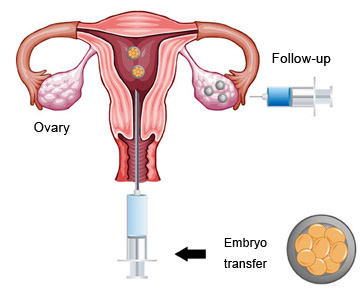FROZEN EMBRYO TRANSFER

Frozen embryo transfer (FET) is a procedure frequently used during intracytoplasmic sperm injection (ICSI) and in vitro fertilization (IVF) procedures. The method is intended to cryopreserve extra embryos after up to two embryos have been transferred to the uterus during a given reproductive cycle. During the IVF procedure, embryos can be frozen at any stage of development. That freezing embryos on Day 5 has benefits. Blastocysts are the name for these embryos
WHY CHOOSE FROZEN EMBRYO TRANSFER?
Development of blastocysts
By allowing embryos to develop for up to 5 days, natural selection is demonstrated by the fact that only the healthiest embryos survive. Blastocysts that are 5 days old are more comparable to naturally developing embryos from a natural reproductive cycle. As a result, there is a higher chance of implantation and pregnancy.
Repository of excess embryos
In the event that your first embryo transfer procedure does not result in pregnancy, the freezing of extra embryos gives you a backup bank.
In addition, frozen embryo transfer (FET) is far less expensive and time-consuming than starting an in vitro fertilization (IVF) operation over at the ovum retrieval stage.
Auctionary uterus
Your doctor might suggest freezing every embryo you create during an IVF cycle, especially if your endometrium has unsatisfactory characteristics. A polyp or an abundance of endometrial fluid might cause an underdeveloped endometrium.
In any case, there are slim possibilities of implantation with a transferred embryo, thus you might be advised to freeze your embryos until your uterus is more amenable
Ovarian Hyperstimulation
Ovarian hyperstimulation is more likely in women with polycystic ovaries.Your embryo transfer may be postponed to the following month to give your ovaries ample time to heal if your ovaries are found to be overly stimulated.
Higher Hormones
Hormone levels that are abnormally high during an IVF cycle can harm the endometrium and lower the likelihood of implantation. A FET the following month is advised in such a situation.
Embryo genetic testing
Preimplantation genetic diagnosis (PGD) and preimplantation genetic screening (PGS) of embryos is a helpful method to screen out embryos that have a harmful genetic tendency.
WHAT ARE THE STEPS OF FROZEN EMBRYO TRANSFER?
EARLIEST SCREENING
Your fertility doctor may screen you and your spouse for illnesses such as Hepatitis B if it wasn't already done during the IVF process.
FREEZING OF EMBRYOS
The chosen embryos are flash-frozen using a superior method called fast freezing. 90% of the embryos survive the freezing process thanks to the procedure's less invasive safeguards for the embryos.
TRANSFER OF FROZEN EMBRYO
Your fertility specialist will thaw one or more embryos and delicately insert them into your uterine cavity whenever your uterus is suitable for embryos.
We only deposit two embryos per cycle because we want to ensure that you have the best pregnancy possible.
Blog List
WHAT IS A BLASTOCYST TRANSFER ROUTINE?
How To Improve The Quality Of Egg For IVF Naturally?
POLYCYSTIC OVARY SYNDROME DIAGNOSIS AND TREATMENT
6 Ways To Eliminate The Chances Of Infertility
How is the Infertility Journey for Non-Carrying Partners?
Fertility treatments lead to twins, triplets, or more
Difference between IVF and ICSI Treatment:
What is the Difference Between IVF and IUI?
Managing relationships during IVF
Polycystic ovary syndrome (PCOS) affects pregnancy
Understanding male infertility
Fertility Terminology & Abbreviations
Preimplantation genetic testing for genetic conditions
 Healthin
Healthin